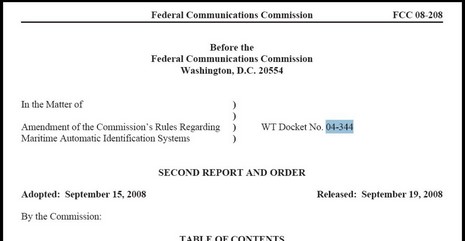Class B AIS, finally the FCC Order

My Class B AIS sources were right! Though it’s not yet in the FCC Daily Digest (Monday, probably), the new AIS Order was released yesterday and is posted as a PDF. And it looks good. If you recall, the FCC could have just granted waivers for the Class B devices already approved by the Coast Guard, but instead the Commissioners have fully approved Class B and dealt with side issues like frequency allocation. The major bit of news I see in the Order is that users will not be permitted to input their own MMSI numbers. However, the new Rule is nicely flexible about who can:
The entry of static data into a Class B AIS device shall be performed by the vendor of the device or by an appropriately qualified person in the business of installing marine communications equipment on board vessels. In no event shall the entry of static data into a Class B AIS device be performed by the user of the device or the licensee of a ship station using the device.
Plus—in addition to meeting the international (IEC) Class B standard, as expected—the FCC Rule requires a label on the device stating how wrong it is to use improper static data. But it seems like it’s OK to use an MMSI gotten free from BoatUS, SeaTow, or whoever, if you don’t get one with an FCC ship license. Of course I may have missed something in all those PDF pages! One thing I’m definitely unsure of is the timing. I think this order goes into effect in 30 days, and there’s some language about granting the requested ACR, Navico, SevenStar, and Software Radio Technology waivers immediately. Thus many of the Class B units I’ve discussed here may be for sale in the U.S.A. as soon as they can print up the warning labels. In the word of my primary behind-the-scenes source (who deserves a huge thanks for keeping us informed): Finally!













Great news! It certainly took them long enough, and after a quick skim of the document it looks like we can thank MariTEL for part of that delay. They disagreed with almost every proposal but in the end were overruled.
I do find the ‘no end user’ entry of static data interesting. Has the ‘professional’ installation of Class-A resulted in consistent and correct static data?
I think you’re right about Maritel, Brian. Did you notice this line:
“We disagree with MariTEL’s contention that the Commission should delay certifying Class B AIS equipment until the Commission determines whether IEC 62287-1 ensures that Class B AIS devices do not cause interference to VPC operations in adjacent spectrum.”
Maritel told me that the company had no objections to Class B.
Sorry, folks, some clarification is in order. I had a premonition that I didn’t completely understand this process. Here’s some guidance from someone who does:
“The Order won’t take affect until its published in the Federal Register, which could take months. But the good news is that wait won’t apply to Class B AIS. The rule is already now effective for them.
However manufacturers still need FCC certification. There’s a batch already waiting to be certified.”
So…, How much is it going to cost for me to have a “Vendor” input my MMSI number? What’s the difference or danger in having the end user enter the MMSI number? After all, we input the number in a new VHF radio all the time and no one is complaining about the end user screwing that up. Was this requested by the Marine Electronics Industry so they can make a fee for doing nothing significant. I would accept this if I thought there was some serious national security reason for guarding what MMSI number goes into a class B AIS, but than you would need to clear every “Vendor” for a security clearance in order to maintain some sort of accountability. Since this is not the case I can only conclude the rule is a money making vehicle only.
KUDOS to everyone who had a hand in bringing this to fruition. While I am sure that AIS A and B have saved lives already, I am also sure this additional measure of safety would still be denied citizens in the United States without your continued encouragement of the FCC. Good things CAN still surmount Institutional Inertia and Bureaucratic Belligerence. Perhaps someday Insurance discounts will help defray some of the costs of installing AIS.
Richard, I don’t think this an electronics industry conspiracy. In fact, I once heard a Furuno rep (at a GMDSS meeting) tell the FCC quite firmly that having manufacturers input MMSI info was a bad idea. I do think that Shine Micro lobbied for better controls on MMSI entry, but I believe their intent is a better working system.
Overall, I don’t think the FCC would have imposed the added regulations if there weren’t so many static data errors already coming from Class A transponders, and/or if the U.S.C.G. didn’t see a Marine Domain Awareness value in AIS.
As for the cost, I guess we’ll just have to see. There is some time involved in collecting a buyer’s static info, unpacking and programming the unit, and then shipping it out or installing it. But I can certainly imagine savvy specialists like Milltech Marine and Shine Micro making the online/mailorder process efficient and hence low cost. Maybe BoatUS will work with West Marine to make getting an MMSI and AIS B one simple process?
Regarding the complaints about not being able to enter your own MMSI number: What you cannot enter is “static data” which includes the MMSI number. This is to prevent clowns from programming 300 feet as the length of their little fishing boat and 3 miles as it’s turning radius; preventing masquerading, if you will. If people are allowed to program garbage the whole system will downgrade. I have not read the order, but an appropriately qualified person might be the holder of a GROL, who has an FCC license to lose if he participates in clowning around.
I have to agree with Arcy, every weekend I see data entered in wrong. Just today I saw a boat with a MMSI of all zero’s, and last week there was a boat where not only did the person confuse Meters for feet, he transposed his length and width. I can only imagine what a 30 meter long x 60 Meter wide boat would look like.
If you want to explore AIS in use, browse
http://ais3.siitech.net/VTSLite/AView.aspx
It doesn’t take long to find static values which are clearly invalid.
Also, despite there being notices etc issued for the past two years, there are still a considerable number of vessels suffering problems with their ACR/Nauticast Class A AIS transponders, which default to a MMSI of 1193046 , “engaged in Fishing”, length of 200 metres etc etc. The default MMSI in particular causes dangerous and unpredictable “target swop” when observing vessels which are using these transponders.
Martin
Have been watching a tug in Baltimore reporting a 0.5m draft but her specs show an 88 inch wheel.
Must be the old inches/feet/meters problem or surface piercing prop?
Doug
The MMSI Input Issue is a “Paper Tiger” at best.
Some West Marine Dock Runner who was flippin’ burgers last week can install one and he is the “Expert” who won’t screw it up? c’mon!
If many of the Class A units are not programmed properly with Static Information, the Class B’s will be a joke. The label will help slightly but there will still be a lot of errors and again, there is no “Teeth” in the requirement!!!
Rick
Probably most people who install AIS Class B units will be interested in making sure it is done correctly. Since it is easy to check what you’re transmitting by having someone else report back what they see over-the-air there is a reliable way to eliminate any errors caused by incorrect data entry.
Punching in a handful of numbers is not beyond the capabilities of your average burger-flipper, and having a second eye look at the data on your AIS might actually be a good idea. There are already too many stupid mmsi-jokes. But the bottom line is this is just a “We-gotta-do-something-cuz-we-took-so-long!” reaction. What ever. Don’t become a statistic; get one.
Do we know, yet, whether or not our BoatUS-issued, ITU-noncompliant MMSI numbers are good enough for Class B AIS units? I wrote about this over on Navagear (http://www.navagear.com/2008/04/all-mmsi-were-the-borogoves/), and I’m still wondering if this issue was partly responsible for the delay.
Tim, I’m pretty sure that BoatUS, Sea Tow, Shine Micro, etc. MMSI numbers will work fine in a Class B AIS. I don’t think they’re “noncompliant”; they just are not registered in the International database and should not be used outside U.S. waters.